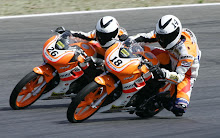Motorcycle fuel economy benefits from the relatively small mass of the vehicle, compared to its passengers and to other motor vehicles, and subsequent small engine displacement. However, poor aerodynamics of exposed passengers and engines designed for goals other than fuel economy can work to reduce these benefits. Riding style has a large effect on fuel economy: some riders report being able to double fuel economy by using low accelerations and lower speeds than usual, although this is the extreme case.
Fuel economy varies greatly with engine displacement and riding style ranging from a low of 29 mpg (U.S.) (8.1 L/100 km) reported by a Honda VTR1000F rider,[4] to 107 mpg (U.S.) (2.2 L/100 km) reported for the Verucci Nitro 50 cc Scooter.[5] A specially designed Matzu Matsuzawa Honda XL125 achieved 470 mpg (U.S.) (0.5 L/100 km) "on real highways - in real conditions."[6]
search

Custom Search
Construction
Motorcycle construction is the engineering, manufacturing, and assembly of components and systems for a motorcycle which results in performance, cost and aesthetics desired by the designer. With some exceptions, construction of modern mass-produced motorcycles has standardised on a steel or aluminium frame, telescopic forks holding the front wheel, and disc brakes. A one- to six-cylinder gasoline powered engine coupled to a manual, five- or six-speed sequential transmission drives the swingarm-mounted rear wheel by a chain, driveshaft or belt.
History
The inspiration for arguably the first motorcycle was designed and built by the German inventors Gottlieb Daimler and Wilhelm Maybach in Bad Cannstatt (since 1905 a city district of Stuttgat) in 1885.[1] The first petroleum-powered vehicle, it was essentially a motorised bicycle, although the inventors called their invention the Reitwagen ("riding car").
However, if one counts two wheels with steam propulsion as being a motorcycle, then the first one may have been American. One such machine was demonstrated at fairs and circuses in the eastern U.S. in 1867, built by Sylvester Howard Roper of Roxbury, Massachusetts.
In 1894, Hildebrand & Wolfmüller became the first motorcycle available for purchase. In the early period of motorcycle history, many producers of bicycles adapted their designs to accommodate the new internal combustion engine. As the engines became more powerful, and designs outgrew the bicycle origins, the number of motorcycle producers increased.
An historic 1941 Crocker
Until the First World War, the largest motorcycle manufacturer in the world was Indian, producing over 20,000 bikes per year. By 1920, this honour went to Harley-Davidson, with their motorcycles being sold by dealers in 67 countries, until 1928 when DKW took over as the largest manufacturer.
After the Second World War, the BSA Group became the largest producer of motorcycles in the world, producing up to 75,000 bikes a year in the 1950s. The German company NSU Motorenwerke AG held the position of largest manufacturer from 1955 until the 1970s.
From the 1960s through the 1990s, small two-stroke motorcycles were popular worldwide, partly as a result of East German Walter Kaaden's engine work in the 1950s.
Today, the Japanese manufacturers, Honda, Kawasaki, Suzuki, and Yamaha dominate the motorcycle industry, although Harley-Davidson still maintains a high degree of popularity in the United States. Recent years have also seen a resurgence in the popularity of several other brands sold in the U.S. market, including BMW, KTM, Triumph, Aprilia, Moto Guzzi and Ducati.
Outside of the USA, these brands have enjoyed continued and sustained success, although Triumph, for example, has been re-incarnated from its former self into a modern world-class manufacturer. In overall numbers, however, the Chinese currently manufacture and sell more motorcycles than any other country and exports are rising. The quality of these machines is asserted to be somewhat lower than their Japanese, European and American counterparts .
Additionally, the small-capacity scooter is very popular through most of the world. The Piaggio group of Italy, for example, is one of the world's largest producers of two-wheeled vehicles. The scooter culture has, as yet, not been adopted widely in North America.
However, if one counts two wheels with steam propulsion as being a motorcycle, then the first one may have been American. One such machine was demonstrated at fairs and circuses in the eastern U.S. in 1867, built by Sylvester Howard Roper of Roxbury, Massachusetts.
In 1894, Hildebrand & Wolfmüller became the first motorcycle available for purchase. In the early period of motorcycle history, many producers of bicycles adapted their designs to accommodate the new internal combustion engine. As the engines became more powerful, and designs outgrew the bicycle origins, the number of motorcycle producers increased.
An historic 1941 Crocker
Until the First World War, the largest motorcycle manufacturer in the world was Indian, producing over 20,000 bikes per year. By 1920, this honour went to Harley-Davidson, with their motorcycles being sold by dealers in 67 countries, until 1928 when DKW took over as the largest manufacturer.
After the Second World War, the BSA Group became the largest producer of motorcycles in the world, producing up to 75,000 bikes a year in the 1950s. The German company NSU Motorenwerke AG held the position of largest manufacturer from 1955 until the 1970s.
From the 1960s through the 1990s, small two-stroke motorcycles were popular worldwide, partly as a result of East German Walter Kaaden's engine work in the 1950s.
Today, the Japanese manufacturers, Honda, Kawasaki, Suzuki, and Yamaha dominate the motorcycle industry, although Harley-Davidson still maintains a high degree of popularity in the United States. Recent years have also seen a resurgence in the popularity of several other brands sold in the U.S. market, including BMW, KTM, Triumph, Aprilia, Moto Guzzi and Ducati.
Outside of the USA, these brands have enjoyed continued and sustained success, although Triumph, for example, has been re-incarnated from its former self into a modern world-class manufacturer. In overall numbers, however, the Chinese currently manufacture and sell more motorcycles than any other country and exports are rising. The quality of these machines is asserted to be somewhat lower than their Japanese, European and American counterparts .
Additionally, the small-capacity scooter is very popular through most of the world. The Piaggio group of Italy, for example, is one of the world's largest producers of two-wheeled vehicles. The scooter culture has, as yet, not been adopted widely in North America.
Subscribe to:
Posts (Atom)



